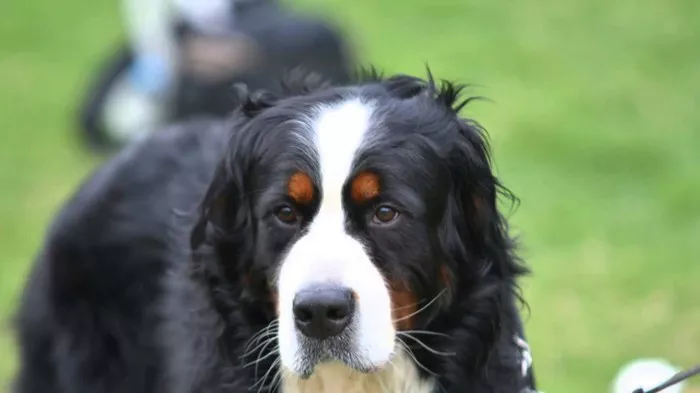The Bernese Mountain Dog, often affectionately known as the Berner, is a large, sturdy breed originating from the Swiss Alps. These dogs are renowned for their beautiful, thick, tricolored coats and their friendly, affectionate nature. Understanding their specific needs, including grooming and bathing, is essential for maintaining their health and well-being.
Coat Characteristics
Thick and Double-Layered
The Bernese Mountain Dog has a double-layered coat. The undercoat is dense and woolly, providing insulation, while the outer coat is long, thick, and slightly wavy or straight, offering protection against the elements. This type of coat is designed to withstand harsh weather conditions, which is reflective of the breed’s origin.
Shedding
Bernese Mountain Dogs are known for their significant shedding, which tends to increase during seasonal changes. Regular grooming helps manage this shedding and keeps the coat healthy.
Importance of Bathing
Skin Health
Regular bathing is crucial for maintaining the skin health of Bernese Mountain Dogs. It helps remove dirt, debris, and allergens that can cause skin irritation and infections.
Coat Maintenance
Bathing also helps keep the coat clean and free of tangles and mats. A clean coat is less likely to harbor parasites like fleas and ticks.
Odor Control
Given their thick coats, Bernese Mountain Dogs can develop a strong odor if not bathed regularly. Bathing helps control this odor and keeps the dog smelling fresh.
Frequency of Bathing
General Guidelines
The general guideline for bathing a Bernese Mountain Dog is once every 1 to 3 months. However, this can vary based on several factors, including the dog’s lifestyle, activity level, and health.
Activity Level
Bernese Mountain Dogs that are very active, particularly those that spend a lot of time outdoors, may require more frequent baths. They are more likely to get dirty and accumulate debris in their coats.
Health Conditions
Dogs with certain health conditions, such as skin allergies or infections, may need to be bathed more frequently with medicated shampoos. Always consult with a veterinarian for specific recommendations in these cases.
Bathing Process
Preparing for the Bath
Brushing
Before bathing, it is important to thoroughly brush the dog’s coat. This helps remove loose hair, tangles, and mats, making the bathing process more effective.
Gather Supplies
Ensure you have all the necessary supplies, including a dog-friendly shampoo, conditioner, a large towel, and a brush. It’s also helpful to have a non-slip mat for the bathing area to prevent the dog from slipping.
Choosing the Right Shampoo
Dog-Specific Shampoos
Always use a shampoo specifically formulated for dogs. Human shampoos can be too harsh and disrupt the natural oils on a dog’s skin.
Hypoallergenic Options
For dogs with sensitive skin, opt for hypoallergenic shampoos. These are gentle and less likely to cause irritation.
Medicated Shampoos
If your Bernese Mountain Dog has specific skin conditions, a medicated shampoo prescribed by your veterinarian may be necessary.
Bathing Steps
Wetting the Coat
Start by thoroughly wetting the dog’s coat with lukewarm water. Make sure the water penetrates through the thick outer coat to the undercoat.
Applying Shampoo
Apply the shampoo and work it into a lather, focusing on areas that tend to get dirtier, like the paws, belly, and hindquarters. Be gentle around the face and avoid getting shampoo in the eyes and ears.
Rinsing
Rinse the coat thoroughly to remove all the shampoo. Any residue left behind can cause skin irritation.
Conditioning
Apply a conditioner if needed, following the same process as with the shampoo. This helps keep the coat soft and manageable.
Final Rinse
Ensure all the conditioner is rinsed out completely.
Drying the Dog
Towel Drying
Begin by towel drying the dog to remove excess water. Bernese Mountain Dogs have thick coats that can retain a lot of water, so be prepared for this step to take some time.
Blow Drying
Using a blow dryer on a low, cool setting can help speed up the drying process. Make sure to keep the dryer moving to avoid overheating any part of the dog’s coat or skin.
Post-Bath Grooming
Brushing
Once the dog is dry, brush the coat again to remove any remaining loose hairs and prevent tangles.
Checking for Issues
While grooming, check for any signs of skin issues, such as redness, bumps, or parasites. Regular checks can help catch potential problems early.
Special Considerations
Puppies
Puppies generally do not require frequent baths. A gentle bath every few months is usually sufficient unless they get particularly dirty.
Senior Dogs
Senior Bernese Mountain Dogs may have different bathing needs. Their skin can become more sensitive, so it’s important to use gentle shampoos and conditioners.
Seasonal Considerations
During shedding seasons (spring and fall), more frequent baths may help manage the increased shedding. Regular brushing is particularly important during these times.
Common Mistakes to Avoid
Over-Bathing
Over-bathing can strip the natural oils from a dog’s skin, leading to dryness and irritation. Stick to the recommended frequency unless advised otherwise by a veterinarian.
Using Harsh Products
Avoid using harsh shampoos or human products on your dog. These can cause skin problems and discomfort.
Improper Drying
Failing to dry the dog thoroughly can lead to skin infections, particularly in dogs with thick coats. Take the time to ensure your dog is completely dry after a bath.
See also: How to Stop Rottweiler from Shedding
Conclusion
Bathing your Bernese Mountain Dog is an essential part of their grooming routine. While the general guideline is to bathe them once every 1 to 3 months, individual needs may vary based on activity level, health, and other factors. By understanding their specific needs and following proper bathing techniques, you can keep your Bernese Mountain Dog healthy, happy, and looking their best. Regular grooming, combined with attentive care, ensures that your beloved Berner remains a beautiful and cherished member of your family.


